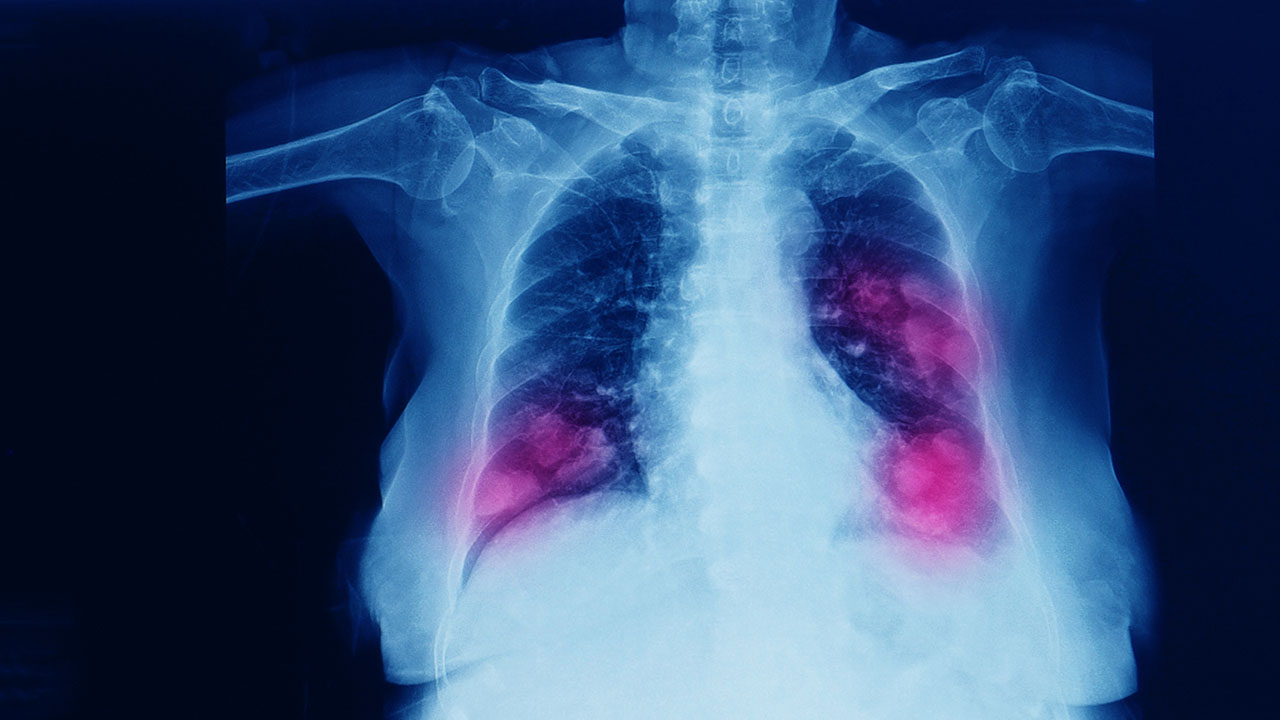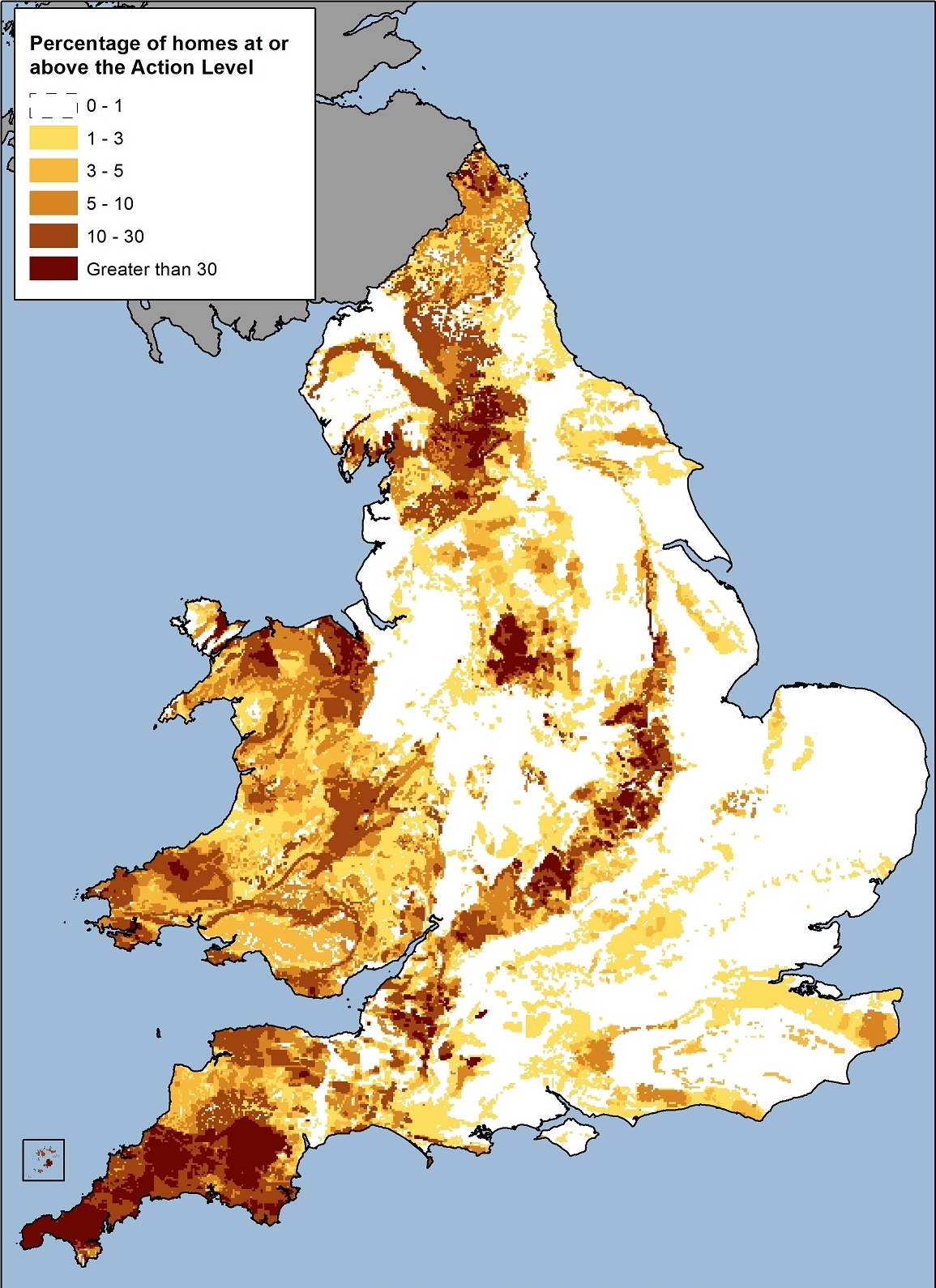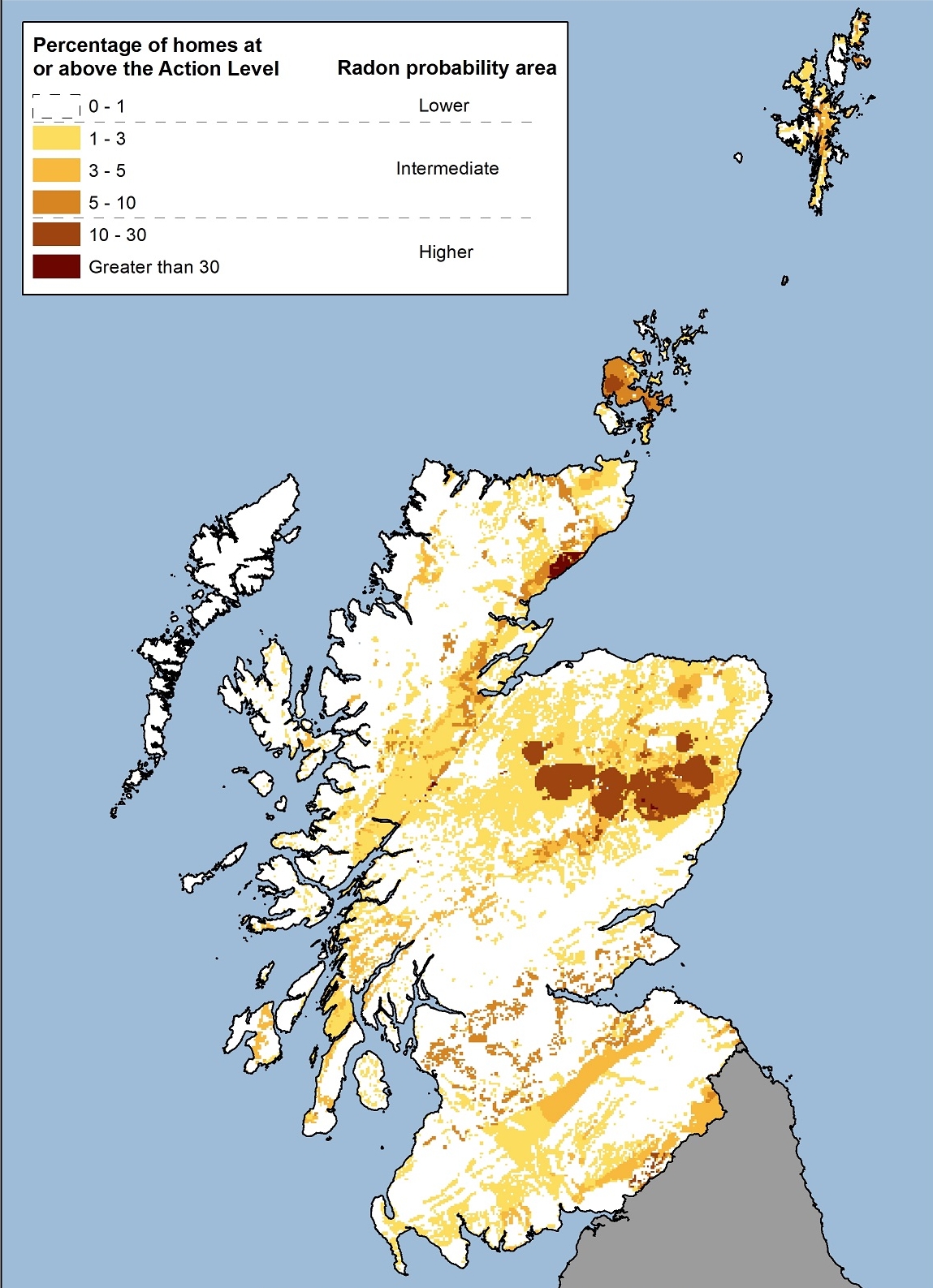
Radon is a radioactive gas but also odourless, tasteless and invisible, which makes it extremely dangerous. It is formed from the radioactive decay of uranium, which is found in rocks and soil almost everywhere in the UK and in many other parts of the world.
Radon concentration is measured in terms of becquerels per cubic metre (Bq/m3), with the mean figure for UK homes being 21Bq/m3. According to the World Health Organization (WHO), the global average of 40Bq/m3 is exceeded in a number of countries. Some European countries with sedimentary soils, such as Germany, the Netherlands, Poland and the UK, have lower or equivalent average 40 Bq/m3 radon levels. However, those with granite soils, such as Austria, the Czech Republic and Finland, are likely to have higher radon concentrations. Taking a common action level of 200Bq/m3 (defined by the WHO), these countries would have to take remedial measures in more than 10% of their homes, compared to only 2.5% in countries with sedimentary soils.
On other continents, the WHO says the highest concentrations of radon are found in parts of Canada and the northern USA. Brazil and Ecuador are among the highest in South America, while in Asia, China, Japan and South Korea are ranked highest.

Health risks
The presence of radon is an essential factor to consider when surveying properties because the gas has a strong link with lung cancer, a risk heightened for people who smoke. In 2006, the British Medical Journal stated that 3.3% of deaths from lung cancer in the UK were caused by radon in the home. The WHO has said that radon is responsible for 3–14% of all lung cancers across Europe.
From an age perspective, 48% of radon-related deaths occur in adults aged between 55 and 74, with only 6% occurring below the age of 55 and virtually none below 35.
Drinking water
Radon can also be found in drinking water but there are requirements for water utility organisations to monitor the radionuclides (radioactive substances that could present a risk to human health). If the measured activity concentrations are below 0.5Bq/l for gross alpha activity (the total radioactivity of all alpha emitters) and 1Bq/l for gross beta activity (the total radioactivity of all beta emitters), then no further action is required (WHO).
However, drinking water drawn from the water table through wells or boreholes may contain higher levels of radon if the home or business location is in one of the shaded areas shown in Figures 1 and 2.
Useful information on testing regimes for supplies and sources of drinking water can be found in the Drinking Water Inspectorate's Manual on Treatment for Small Water Supply Systems and the WHO's Guidelines for Drinking Water.

Radon controls
Since 1999, Approved Document C of the Building Regulations in England, Site preparation and resistance to contaminants and moisture, has specified that all new homes should be built with a radon and damp-proof membrane and, in more affected areas, a sump under the building. There are similar rules in place for Wales, Scotland and Northern Ireland. Public Health England (PHE) advises that radon levels in new houses should be tested in the first year of occupation.
Existing homes in affected areas should also be checked and measured to bring radon levels within safety limits or eliminate them entirely (with actions such as installing a sump system underneath the property). In all areas, concentrations above the action level of 200Bq/m3 should be reduced as far as possible.
These various rules are drawn together in the 2015 BRE report BR 211 Radon: Guidance on protective measures for new buildings, which includes advice for all building types including extensions, conversions and refurbishments. It offers extensive guidance on the technical measures that are required to satisfy the Building Regulations.
The National Radiological Protection Board, part of PHE, also provides useful guidance, and maintains a list of laboratories that carry out radon testing. In 2009, the HPA recommended that, in general, all ground-floor and below-ground workplaces should undergo a radon assessment, with measurements taken in all premises in radon-affected areas. This process commences with a radon risk assessment, which can be undertaken using the PHE online dose record keeping service or the BRE's guidance sheets.
Housing act responsibilities
Radon gas is covered in section 9 of the Housing Act 2004 and the need for action is outlined in the Housing Health and Safety Rating System (HHSRS), where it is number 8 in the list of 29 categorised hazards. Landlords also have a responsibility to their tenants under various duties of care such as those in section 4 of the Defective Premises Act 1972, as well as the 2004 Act, to provide a safe home. They should carry out a radon test if levels are found to be more than the domestic action level of 200Bq/m³ as mandated by PHE's 2010 report Limitation of Human Exposure to Radon, 2010.
The HHSRS states: "If the dwelling is in an affected area, then the construction and condition of the ground floor and the presence of open chimney flues and the means of ventilation should be assessed. If present, the state of any remediation measures should be checked. However, the condition of these will only indicate that there could be a problem. And, as radon levels can vary widely between apparently identical dwellings, the only way to determine whether or not there is a threat to health is by measurement."
Workplace safety
The WHO has found that the radon levels inside buildings such as homes, schools and offices are in the range of 10–10,000Bq/m3. The average outdoor radon level is 5–15Bq/m³; however, levels of more than 10,000Bq/m3 have been found. Generally, concentrations of radon in the outside air are lower because particles are more widely dispersed.
The Ionising Radiation (Basic Safety Standards) (Miscellaneous Provisions) Regulations 2018, which apply to commercial buildings, mean that employers must adhere to a new radon exposure limit of 300Bq/m3 in the workplace, rather than the previous level of 400Bq/m3. An employer may be required to take immediate action to take steps (such as improvements to natural underfloor ventilation) to reduce radon levels below the safety limit. This could require a consultation with a radiation protection adviser and an ongoing monitoring regime.
The Health and Safety at Work etc. Act 1974 places a duty on organisations to carry out a radon risk assessment where a UK workplace is located below ground, particularly in an area of high radon concentration, which is occupied for more than 1 hour per week or a minimum of 50 hours per year. In such cases, an annual inspection and testing regime is recommended. There are simple-to-use dose meters that can be ordered for this purpose and returned to recognised laboratories.
Organisations and employers are only required to notify the Health and Safety Executive once remediation work shows that levels cannot be reduced below the new 300Bq/m3 limit.
Identifying radon and measuring its impact is a hugely complicated field and the gas can have significant health implications for occupants of homes and other properties. Unsurprisingly, there are many rules and regulations to protect occupants, and building owners, landlords and surveyors must ensure they are aware of these to fulfil their duties appropriately.
The next article will look at mitigating radon risks in the home and focus on the most effective remedial measures.
Related competencies include: Building pathology, Housing maintenance, repairs and improvements, Inspection, Legal/regulatory compliance, Maintenance management
"Landlords should carry out a radon test if levels are found to be more than the domestic action level of 200Bq/m³"
